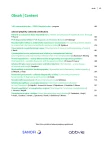Development of views on pathophysiology of sepsis
Authors:
Jiří Beneš
Authors‘ workplace:
Klinika infekčních nemocí 3. LF UK a Nemocnice Na Bulovce, Praha
Published in:
Vnitř Lék 2017; 63(7-8): 481-487
Category:
Reviews
Overview
Sepsis was understood as a disease caused by an invasive bacterial infection associated with deluging of organism with bacterial toxins (blood poisoning). Schottmüller’s definition emphasized the existence of a focus as the source of invading bacteria. Further research led to the discovery of the cytokine cascade and to the recognition that sepsis is induced by our own endogenous mediators. The dysfunction or failure of various organs in sepsis can be explained both by hemodynamic disorders which originate in the altered microcapillars but also by a complex transformation of metabolism. To explain metabolic changes, the theory of tissue hibernation was postulated. According to the alternative theory, metabolic changes arise due to attenuation of mitochondrial function, which develops as part of a complex antibacterial response. Definitions of sepsis from the mid-19th century to the present are described.
Key words:
pathogenesis of sepsis – sepsis – sepsis definition – septic shock
Sources
1. Historie sepse. Webové stránky Německé společnosti o sepsi. Dostupné z WWW: <http://www.sepsis-gesellschaft.de/DSG/Englisch/Disease+pattern+of+Sepsis/Sepsis+History>.
2. Bingold K. Die septischen Erkrankungen. Infektionskrankheiten. 4th ed. Springer Verlag: Berlin 1952 : 943–955.
3. Spraycar M (ed). Stedman´s Medical Dictionary. 26th ed. Wiliams & Wilkins: Baltimore 1995. ISBN 978–0683079227.
4. Carswell EA, Old LJ, Kassel RL et al. An endotoxin-induced serum factor that causes necrosis of tumors. Proc Natl Acad Sci USA 1975; 72(9): 3666–3670.
5. Green S, Dobrjansky A, Carswell EA et al. Partial purification of a serum factor that causes necrosis of tumors. Proc Natl Acad Sci USA 1976; 73(2): 381–385.
6. Clark IA. Suggested importance of monokines in pathophysiology of endotoxin shock and malaria. Klin Wochenschr 1982; 60(14): 756–758.
7. Michie HR, Manogue KR, Spriggs DR et al. Detection of circulating tumor necrosis factor after endotoxin administration. N Engl J Med 1988; 318(23): 1481–1486.
8. Thomas L. Germs. N Eng J Med 1972; 287(11): 553–555.
9. Riedemann NC, Guo RF, Ward PA. The enigma of sepsis. J Clin Invest 2003; 112(4): 460–467.
10. Bone RC, Balk RA, Cerra FB et al. Definitions for sepsis and organ failure and guidelines for the use of innovative therapies in sepsis. The ACCP/SCCM Consensus Conference Committee. American College of Chest Physicians/Society of Critical Care Medicine. Chest 1992; 101(6): 1644–1655.
11. Průcha M, Fedora M, Kieslichová E et al (eds). Sepse. Maxdorf Jessenius: Praha 2015. ISBN 978–80–7345–448–7.
12. Levy MM, Fink MP, Marshall JC et al. 2001 SCCM/ESICM/ACCP/ATS/SIS International Sepsis Definitions Conference. Intensive Care Med 2003; 29(4): 530–538.
13. Siegel JH, Cerra FB, Coleman B et al. Physiological and metabolic correlations in human sepsis. Invited commentary. Surgery 1979; 86(2): 163–193.
14. Bone RC. The pathogenesis of sepsis. Ann Intern Med 1991; 115(6): 457–469.
15. Cerra FB, Siegel JH, Border JR et al. Correlations between metabolic and cardiopulmonary measurements in patients after trauma, general surgery, and sepsis. J Trauma 1979; 19(8): 621–629.
16. Cerra FB, Siegel JH, Coleman B et al. Septic autocannibalism. A failure of exogenous nutritional support. Ann Surg 1980; 192(4): 570–580.
17. Azevedo LC. Mitochondrial dysfunction during sepsis. Endocr Metab Immune Disord Drug Targets 2010; 10(3): 214–223.
18. Harrois A, Huet O, Duranteau J. Alterations of mitochondrial function in sepsis and critical illness. Curr Opin Anaesthesiol 2009; 22(2): 143–149. Dostupné z DOI: <http://dx.doi.org/10.1097/ACO.0b013e328328d1cc>.
19. Kula R, Chýlek V, Szturz P et al. A response infection in patients with severe sepsis: do we need a „stage-directed therapy concept“? Bratisl Lek Listy 2009; 110(8): 459–464.
20. Kula R, Chýlek V, Szturz P et al. Patogeneze těžké sepse – od makrocirkulace k mitochondriím. Klin Mikrobiol Inf Lék 2006; 12(4): 143–149.
21. Singer M. Cellular dysfunction in sepsis. Clin Chest Med 2008; 29(4): 655–660. Dostupné z DOI: <http://dx.doi.org/10.1016/j.ccm.2008.06.003>.
22. Lane N. Síla, sexualita, sebevražda. Mitochondrie a smysl života. Academia: Praha 2012. ISBN 978–80–200–2073–4.
23. Vincent JL, Opal SM, Marshall JC et al. Sepsis definitions: time for change. Lancet 2013; 381(9868): 774–775. Dostupné z DOI: <http://dx.doi.org/10.1016/S0140–6736(12)61815–7>.
24. Singer M, Deutschman CS, Seymour CW et al. The Third International Consensus Definitions for Sepsis and Septic Shock (Sepsis-3). JAMA 2016; 315(8): 801–810. Dostupné z DOI: <http://dx.doi.org/10.1001/jama.2016.0287>.
25. Sklienka P, Beneš J, Máca J. Definice sepse 2016 (Sepsis-3). Anest Intenziv Med 2016; 27(5): 302–308.
26. Holub M, Beran O. Nová definice sepse a septického šoku – Sepsis 3. Klin Mikrobiol Inf Lék 2016; 22(4): 141–143.
27. Matějovič M. Sepse a její nová definice. Postgrad Nefrol 2017; 15(1): 4–8.
28. Jones AE, Trzeciak S, Kline JA. The Sequential Organ Failure Assessment score for predicting outcome in patients with severe sepsis and evidence of hypoperfusion at the time of emergency department presentation. Crit Care Med 2009; 37(5): 1649–1654. Dostupné z DOI: <http://dx.doi.org/10.1097/CCM.0b013e31819def97>.
29. Septicemia. In: Encyclopaedia Britannica. Dostupné z WWW: <https://www.britannica.com/science/septicemia>.
Labels
Diabetology Endocrinology Internal medicineArticle was published in
Internal Medicine

2017 Issue 7-8
Most read in this issue
- Nosocomial pneumonia
- PCR diagnosis of infectious diseases
- The current problems related to nosocomial infections and antibiotic resistance today
- Community pneumonia – fundamentals of diagnosing and treatment
